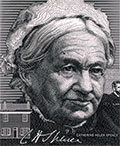Catherine Helen Spence (1825–1910)

Journalist, social and political reformer, novelist and feminist.
Catherine Helen Spence was the leading woman in public affairs at the turn of the century in Australia. She was in the vanguard of first-wave feminism seeking equality of opportunity for women in this country, and was lauded as the ‘Grand Old Woman of Australia’. From the pulpit to the platform, she championed the rights of women, lobbied for greater child welfare provision and argued for a more democratic electoral system.
1825: Spence was born in Melrose, Scotland.
1839: She emigrated to South Australia at the age of 14 with her family.
1843: She worked as a governess and later ran a small private school.
1850: She turned to journalism in her mid-twenties to fulfil her childhood ambition. Her articles were mainly on literature, politics and social issues.
1854: She is credited as the first woman novelist in Australia to portray antipodean issues with the publication of her first novel, Clara Morison: A Tale of South Australia.
1856: Around 1856, Spence converted from the Presbyterianism of her upbringing to Unitarianism.
1859: Her interest in electoral reform was sparked by an article on the Thomas Hare system of proportional representation, by the English social philosopher John Stuart Mill. She became an inveterate pamphleteer on the topic.
1872: Spence's faith imbued her philanthropic endeavours. In 1872, she had co-founded the Boarding-Out Society, a voluntary organisation which superintended the fostering-out of state dependent children.
1872–1886: She alternated between the offices of Honorary Treasurer and Honorary Secretary from 1872 until 1886. The next year the Society's functions were taken over by the new State Children's Council, of which she was an active member from its inception until just before her death.
1877: An advocate of public education, she was appointed to a local school board.
1878: She became South Australia's first woman preacher when she delivered a sermon to the Adelaide congregation.
1879: She supported the establishment of the first government secondary school, the Advanced School for Girls.
1880: The South Australian Education Department published her book The Laws We Live Under. This textbook broke new ground by outlining citizens' rights and responsibilities. It foreshadowed the introduction of courses on civics and legal studies in curricula across the country throughout the 20th century.
1891: Spence joined the growing movement to secure the vote for women and became a Vice-President of the Women's Suffrage League.
1892: She proposed a modified version of electoral reform pamphlets.
1893–1894: She pushed the suffragists' claims during her electoral reform campaign and throughout her lecture tour of the United States and Britain.
1894: She returned to Australia in December 1894 to witness the historic passing of the Constitution Amendment Bill through Parliament giving voting rights to the women of South Australia, the first Australian colony to do so.
1895: She formed the Effective Voting League of South Australia and campaigned for the introduction of the scheme into the Colony's electoral system.
1897: She was the first woman appointed to the Colony's Destitute Board, commissioned in 1849 to alleviate poverty. Spence became Australia's first female political candidate when she contested, unsuccessfully, the election for delegates to the 1897 Australasian Federal Convention. She had campaigned on the single issue of proportional representation.
1909: Spence presided over the formation of the Women's Non-Party Political Association, which later became the League of Women Voters of South Australia.
1910: Catherine Helen Spence died on 3 April 1910 in Norwood, Adelaide.
1911: The Catherine Helen Spence Scholarship, awarded to women to study social issues, was established by the South Australian Government to perpetuate her memory.
1999: A plaque honouring Spence's achievements was installed at her Scottish birthplace.
Assistance from the State Library of New South Wales in the preparation of this biography is acknowledged.
Further information is available in Notable Australians.